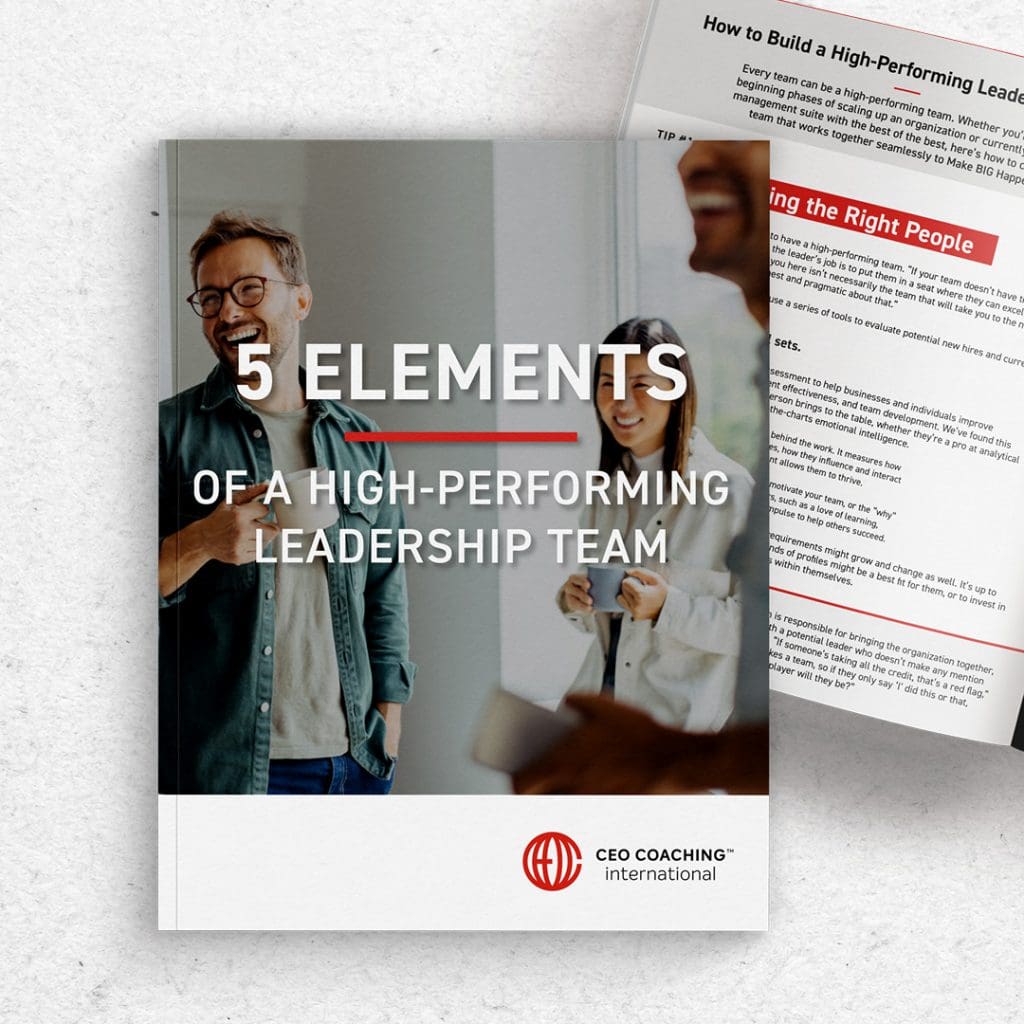
How to Hire a High-Performing Leadership Team
Every team can be a high-performing team.
But that starts with the right people in the right seat.
As CEO, you’re responsible for five main tasks: Vision, Cash, People, Key Relationships, and Learning. Today, we’re focusing on one of the most challenging responsibilities for a leader: People.
You need to learn how to delegate well. As someone who undoubtedly became successful because they were willing to roll up their sleeves and get the job done, pivoting your skill set to managing and inspiring others can be difficult.
But it’s the only way you can scale your business.
What makes it easier? Hiring A-players that can work well together, not just on their own. “If your team doesn’t have the competency and capabilities to execute, then the leader’s job is to put them in a seat where they can excel. What makes it tough is that the team that got you here isn’t necessarily the team that will take you to the next step,” says coach Edward Hughes. “You have to be honest and pragmatic about that.”
Whether you’re in the beginning phases of scaling up an organization or currently have a management suite with the best of the best, here’s how to create a team that works together seamlessly to Make BIG Happen:
1. Ask the right interview questions
Filling a leadership position is especially difficult because as CEO, you’re picking up the slack. It can be easy to just say yes to the first person you click with just to get some relief. Don’t make that mistake. These are the people you’re trusting to lead your organization—they need to hit both the competency required to successfully do the job, and also fit with the culture you’re trying to shape.
As you move through the hiring process, use a consistent set of questions and criteria to evaluate your leadership team. This eliminates any biases you might have (and we all have them.)
A few questions that can help you evaluate potential leaders include:
- Why do you want this role? What is your ideal job?
- Why do you want to work here, specifically, at this organization?
- What were some challenges you faced in X role and how did you break through them?
- Tell me about a time when you disagreed with a coworker about a high-stakes situation. How did you handle it?
- Tell me about a time when you weren’t aligned with your boss. How did you know? And how did you achieve that alignment with them?
- Where do you think you can add the most value here?
- Describe what a successful team environment looks like for you.
Says Edward, “I’m trying to judge if there’s a fit with the organization I’m running, rather than telling them here’s the job and what it’s going to be. Can I take this person who is already a successful person and put them in my organization so they can be successful right away, or will I need to adapt everything in my organization? You need to understand who they are and how they operate.”
2. Assess your team’s strengths and weaknesses
At CEO Coaching International, we often recommend a two-part TTI personality assessment to help businesses and individuals improve communication, productivity, management effectiveness, and team development. These two tests identify the key skill sets each person brings to the table—so you can determine whether your current leadership team has what it takes to get your organization to the next level.
- DISC measures someone’s resilience and problem-solving capabilities, including how they interact with others and the type of work environment they can succeed best in.
- Driving Forces evaluates motivational factors, such as a love of learning, satisfaction in achieving practical results, or an impulse to help others succeed.
As your organization grows and changes, these requirements might grow and change as well. It’s up to you to evaluate your leadership team and what kinds of profiles might be the best fit for those roles, or to invest in coaching and help individuals cultivate those skills within themselves.
3. Use the 9-Box Grid to evaluate potential new hires
As new team members get up and running, think about them using two levers: Potential and Performance.
At CEO Coaching International, we use a framework called the 9-Box Grid to evaluate team members.

Ideally, of course, you’d have a grid full of everyone in the top right (high potential, high performance.) More likely, your team will be scattered throughout the grid.
Pay attention to:
- High-potential, but moderate performance: These are typically the employees who will benefit the most from more training, mentorship, or coaching. If the CEO and team leaders can nudge these employees into upper-right green squares with the other superstars, you’ll improve productivity in the short term while also nurturing potential long-term leaders.
- Moderate performance or potential: You need to have a serious conversation with folks that fall in the moderate category. What’s holding them back? Be clear and direct about what needs to improve, and offer whatever support you can to help them realize their potential.
- Low-low: Everyone deserves a second chance. Give these team members an honest assessment and make sure they’re aware of what the issue is and why it’s important for them to get back on track.
After several decades of being an entrepreneur and an executive coach, I can tell you the longest time in a leader’s life is the time between when you lose confidence in someone and the time you do something about it. For both new hires and existing team members, you need to ask yourself if they fit with your vision for the company moving forward.
High-performing teams need high-performing leaders
As you build a high-performing culture for your team, don’t forget yourself. “Every leader needs to be aware of their blind spots, and that’s a lot of what we do as CEO coaches. You can be the most brilliant CEO, but sometimes you may be missing a way to be a better leader of your organization,” says Edward.
Working with an expert can be just the outside perspective you need to stick to the system, maintain momentum, and keep Making BIG Happen. That’s why hiring a coach can be one of the best decisions you’ll ever make.
Learn more with our free ebook, 5 Elements of a High-Performing Leadership Team

Build Your Dream Team
If you’re struggling with accountability, misaligned goals, or having the right people in the right seats, 5 Elements to a High-Performing Leadership Team is your next step. This free eBook provides proven strategies to build a team that delivers results and helps you Make BIG Happen. Download your copy today.
About CEO Coaching International
CEO Coaching International works with CEOs and their leadership teams to achieve extraordinary results quarter after quarter, year after year. Known globally for its success in coaching growth-focused entrepreneurs to meaningful exits, CEO Coaching International has coached more than 1,000 CEOs and entrepreneurs in more than 60 countries and 45 industries. The coaches at CEO Coaching International are former CEOs, presidents, or executives who have made BIG happen. The firm’s coaches have led double-digit sales and profit growth in businesses ranging in size from startups to over $10 billion, and many are founders that have led their companies through successful eight, nine, and ten-figure exits. Companies working with CEO Coaching International for two years or more have experienced an average EBITDA CAGR of 53.5% during their time as a client, more than three times the U.S. average, and a revenue CAGR of 26.2%, nearly twice the U.S. average.
Learn more about executive coaching | Meet our world-class coaches





